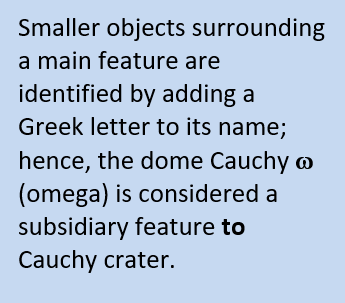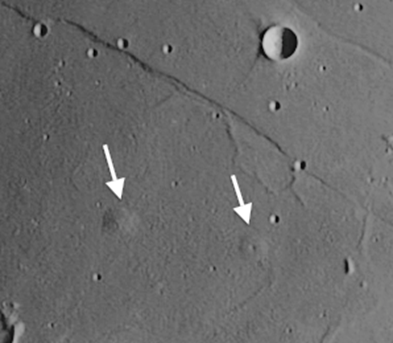The week of February 26 – March 3 takes us from Day 17 to 23. This week we will highlight Rupes Cauchy, viewable on Tuesday night and located in the NE quadrant of the Field Map at J13.
Rupes Cauchy: [NE/J13; L=37°E] (This may not be observable until Day 5 but is mentioned here because the nearby Cauchy domes must be observed at early lunar sunrise.) Two of the best-known faults on the Moon are Rupes Cauchy and Rupes Recta [Day 8; SW/M9]. They are fascinating to explore and they share remarkably similar neighborhoods: Both features are paralleled by a nearby rille, and in each case an intervening small crater separates the rille and the fault.
Seven miles northeast of Cauchy crater you will find Rima Cauchy, a rille that is 130 miles long, 2½ miles wide, and twists itself into a tight double u-turn halfway between Cauchy crater and the rille’s northwest end. To the southwest of Cauchy is the 75-mile Rupes Cauchy, an impressive fault that actually changes into a rille at both ends. The changeover point occurs coincidentally at two small craters that mark where the fault line starts to curve slightly to the southwest. Look carefully and see if you can detect the difference between a rima (a long groove) and a rupes (a cliff). This will be more obvious at lunar sunrise as the Moon’s surface is higher on the northeast side of the fault and a conspicuous shadow will be cast toward the west. On Day 18 the setting Sun brightly illuminates the westward-facing slope of the fault. Because these two features are radial to the Serenitatis Basin they are probably associated with stresses that resulted from the Serenity impact nearly 3.9 billion years ago.

 Cauchy domes: [NE/J13; L=36°E] During sunrise and sunset over this area you will have an opportunity to view the first of your lunar domes, low rounded features that resulted from magma which rose from underneath and created blister-like hills on the Moon’s surface. Sometimes the lava actually burst out of the tops of these domes and you can still see the resulting vents. Both types of domes can be seen here just south of Rupes Cauchy. Can you see the tiny crater pit on top of Cauchy Ω (omega), the dome to the east?
Cauchy domes: [NE/J13; L=36°E] During sunrise and sunset over this area you will have an opportunity to view the first of your lunar domes, low rounded features that resulted from magma which rose from underneath and created blister-like hills on the Moon’s surface. Sometimes the lava actually burst out of the tops of these domes and you can still see the resulting vents. Both types of domes can be seen here just south of Rupes Cauchy. Can you see the tiny crater pit on top of Cauchy Ω (omega), the dome to the east?
It is highly recommended that you get a copy of Sky and Telescope’s Field Map of the Moon, the very finest Moon map available for use at the telescope. It is available for $10.95 at www.skyandtelescope.com and on Amazon. All features mentioned in this blog will be keyed to the grid on the Field Map and will look like this: Plato: [NW/D9]
Credits:
Courtesy of Gray Photography of Corpus Christi, Texas
Lunar photos: NASA / USGS / BMDO / LROC / ASU / DLR / LOLA / Moon Globe. Used by permission
- Rupes Cauchy: A Best Known Fault on the Moon - July 22, 2024
- Moon Crater Schickard – Crater Floor has Stripes - July 15, 2024
- Moon Craters Langrenus and Vandelinus - July 8, 2024